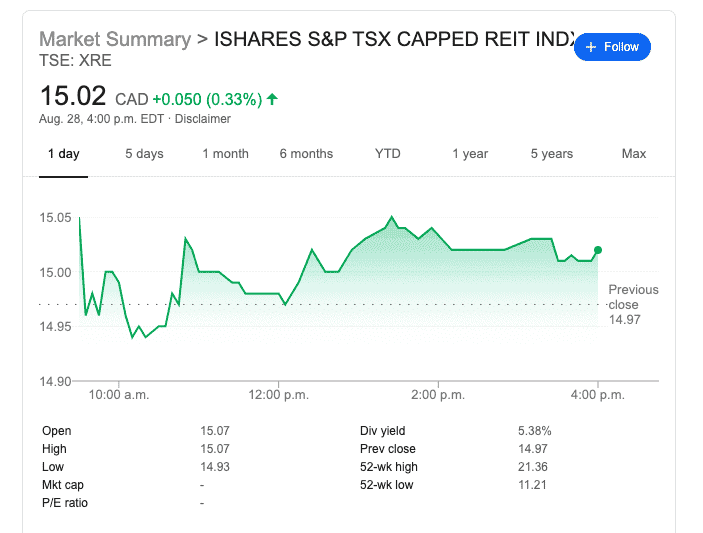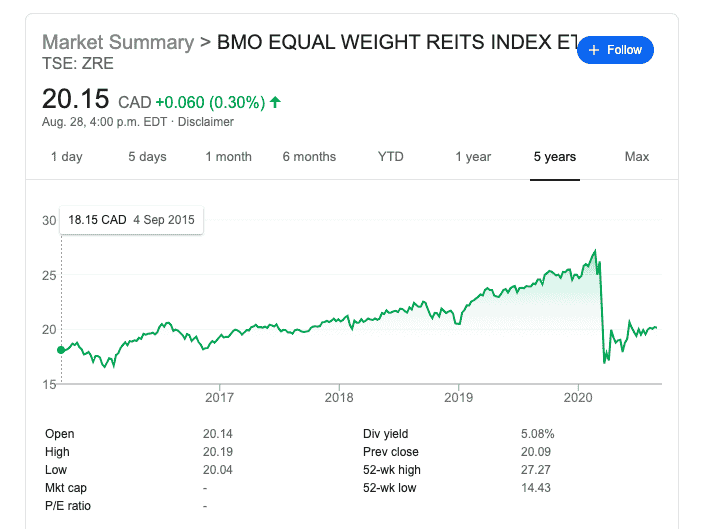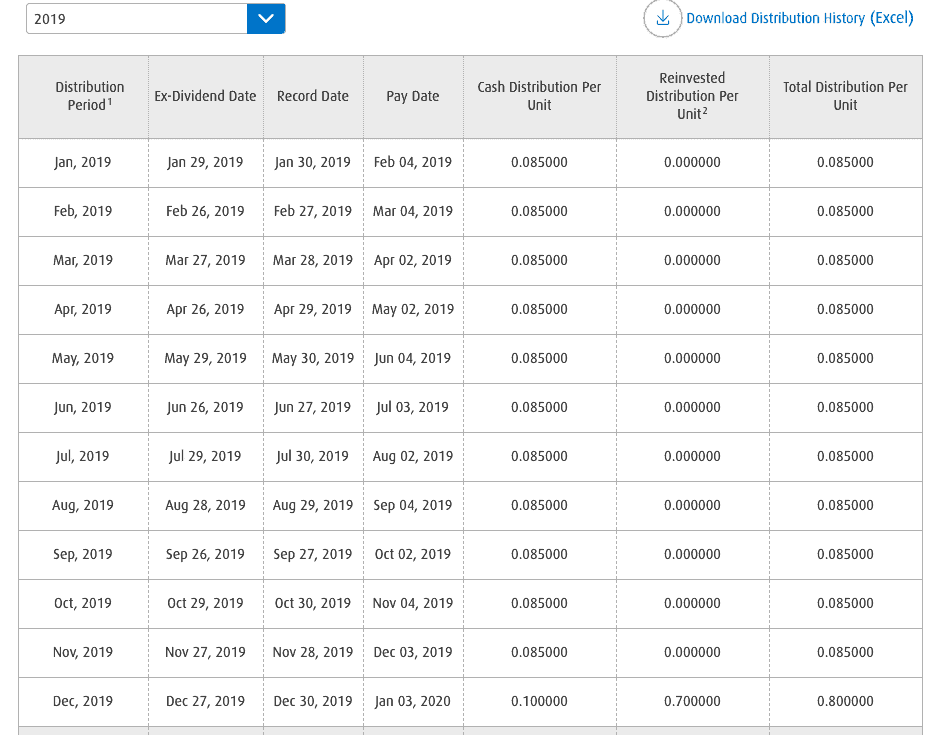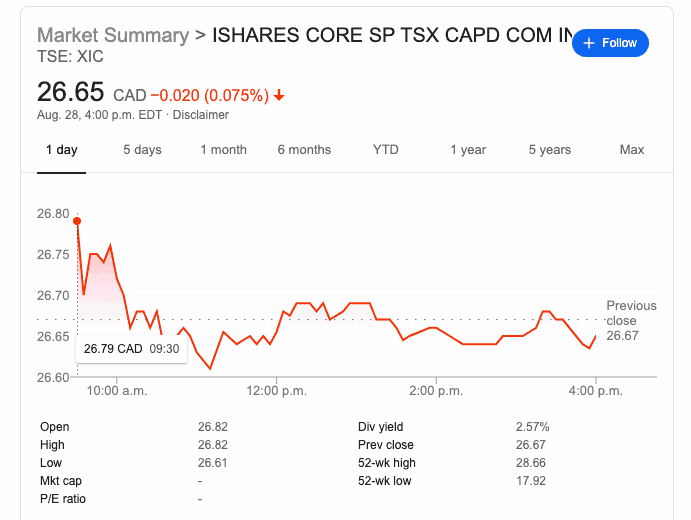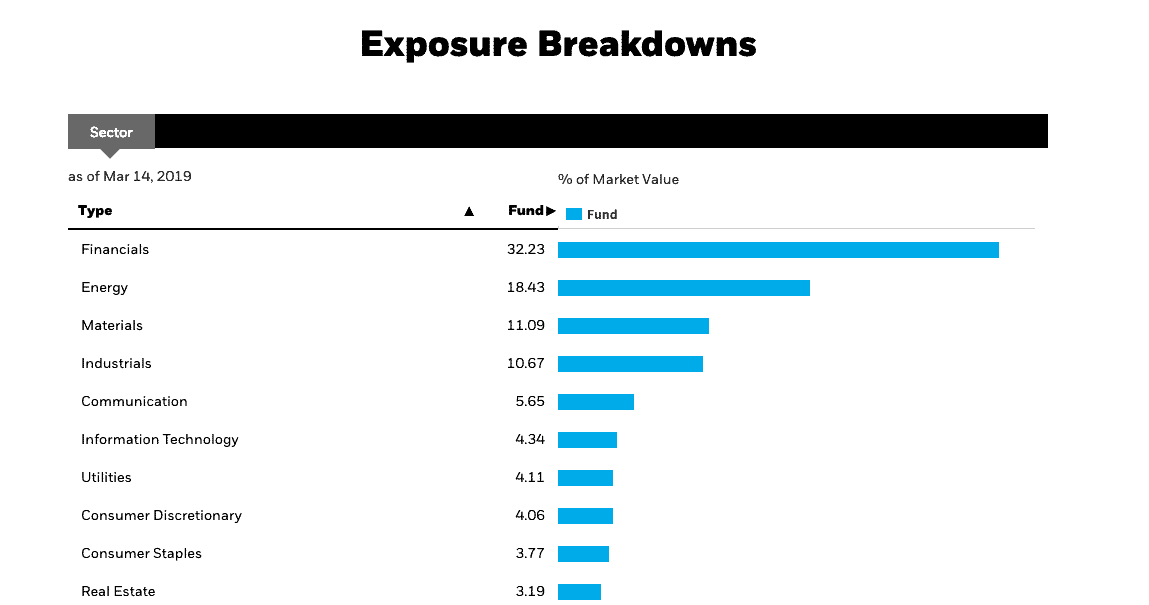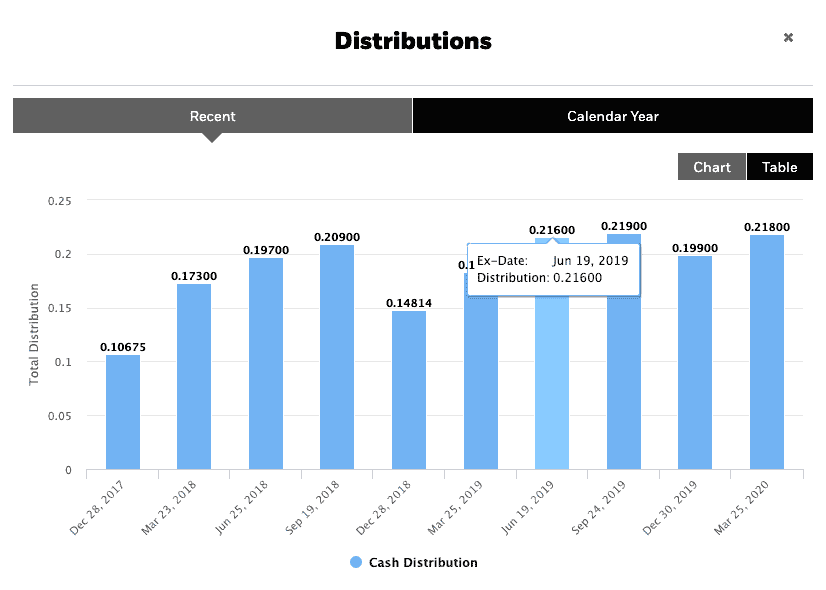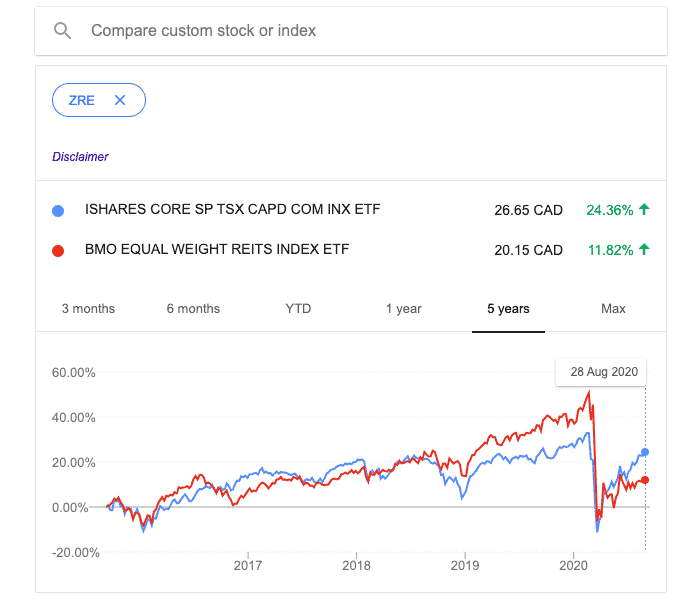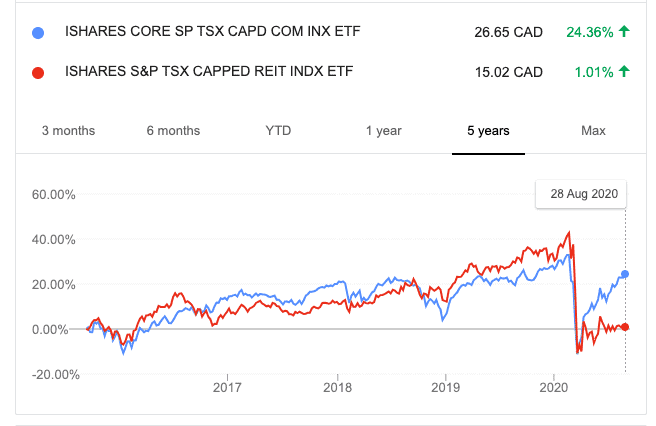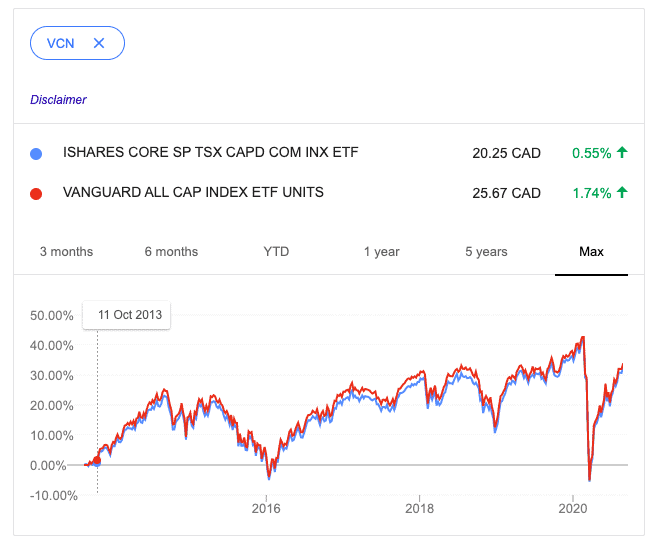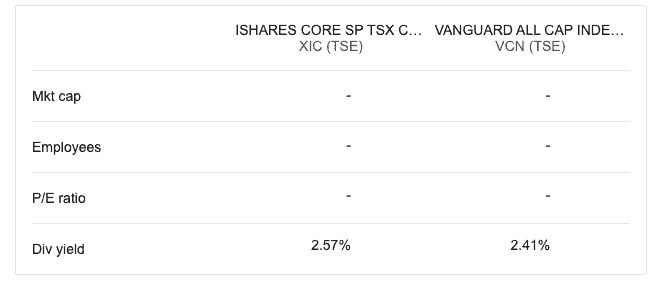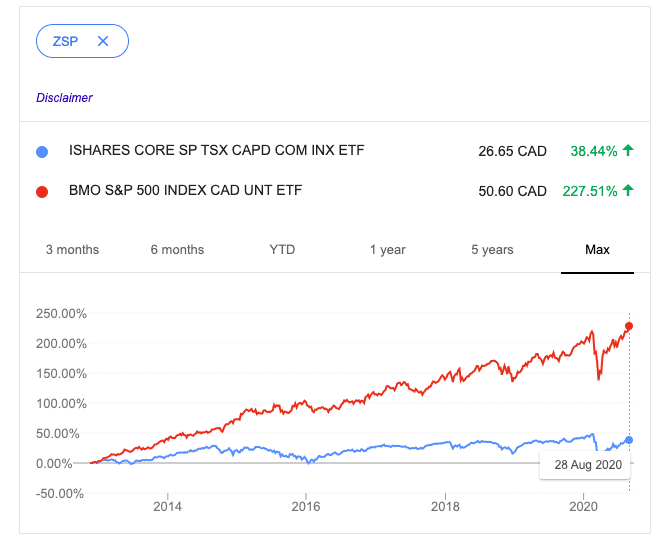When we talk about XRE, XIC or ZRE – we are talking about three great Canadian ETFs on the radar. All three are great picks and performers. However, they are fundamentally very different in the very way they function and how they track the index.
XRE, ZRE & XIC are all Canadian ETFs, tracking different sectors in the TSX index. While XRE And XIC are from Blackrock, ZRE is from BMO.
XRE tracks the S&P/TSX Capped REIT Index, a modified cap-weighted index while VRE tracks the FTSE Canada All Cap Real Estate Index Capped 25% Index, a cap-weighted index which prevents individual holdings from exceeding 25%.ZRE differs the most in that it tracks an equal-weighted index of Canadian REITs where each holding is held in an equal amount.
When it comes to XIC, it tracks the Toronto Stock Exchange, which represents the Canadian equity markets. Again this includes all the small, medium and large businesses throughout all the Canadian manufacturing sectors.
An interesting thing to note about XIC is that it caps exposure to any one security (sector in simple terms) at 10%, therefore reducing concentration risk.
As I said, all these three ETFs – XIC, XRE or ZRE are excellent performers in the market and have performed great over the years time and again. Now, then, let’s get started.
1. XRE – iShares S&P/TSX Capped REIT Index Fund
First of all, XRE is an excellent pick if you are a dividend investor/ have that mindset. Stock’s growth here is very minimal or negligible when or VCN which tracks the TSX 60 Index.
XRE currently trades at $15.02 CAD in the Toronto Stock Exchange (TSE). The dividend yield is a healthy 5.38% with a market cap of 1.4 Billion Dollars. The year to date returns of XRE stands at -20.5%.
Here’s XRE’s overall fund objective – “XRE seeks to provide long-term capital growth by replicating, to the extent possible, the performance of the S&P/TSX Capped REIT Index”
What that means to normal investors like you and me is – By buying one ETF or one stock of XRE, you are pretty much holding the entire REIT or Real Estate market in Canada and the US (partially).
All of the money in this ETF is invested in buying the individual REIT stocks, majorly Canadian and others from the rest of the world. As you might know, REIT stocks are mainly kept for their lucrative dividend yield and so does XRE.
XRE’s dividend is excellent at more than 5% monthly and the stock does well in terms of growth too. Not great, but ok.
If you are looking for growth + dividend stocks, I’ve covered many articles on this blog, so do check them out when you get time.
Why Invest In XRE?
Here are a couple of reasons why you might want to pick XRE over others:
1. Exposure to almost all of the Canadian Real Estate Income Trusts (REITs)
2. You’ll be exposed to different types of REITs in a single fund, such as the retail, residential, office and industrial
3. Receive monthly distributions (More than 5% monthly is the current distribution rate)
How Does XRE Invest Your Money?
Under the regular market conditions, XRE will primarily invest in equity securities issued by Canadian small-capitalization issuers and Canadian real estate investment trust issuers or in simple terms Canadian REITs.
Canadian REIT Index is mainly comprised of constituents of the S&P/TSX Composite Index with GICS Industry code 404020.
Key Fund Facts Of XRE
Below are some important numbers of XRE:
-
Net Assets – CAD 1,314,799,049
-
Inception Date –Oct 17, 2002
-
Exchange – Toronto Stock Exchange
-
Asset Class –Real Estate
-
Benchmark Index – S&P/TSX Capped REIT Index
-
Index Provider – Standard & Poors
-
Fiscal Year-End –Dec 31, 2014
-
Rebalance Frequency – Quarterly
-
Number of Holdings –16
-
Price –18.60
-
Options Available – No
Top 10 Investment Holdings Of XRE
Below you can find the top 10 holdings of XRE. Again this is not the complete list of holdings by this ETF, it’s only the top 10 based on the overall portfolio.
All 10 of them are some of the biggest names in the Canadian REIT Index. That’s what I said earlier, buying one stock of XRE is similar to buying every Canadian REIT Stock out there in the market.
| Ticker | Name | Sector | Weight (%) |
|---|---|---|---|
| REI.UN | RIO CAN REAL ESTATE | Real Estate | 15.10 |
| CAR.UN | CANADIAN APARTMENT PROPERTIES | Real Estate | 14.14 |
| HR.UN | H & R REAL ESTATE INVESTMENT TRUST | Real Estate | 12.36 |
| AP.UN | ALLIED PROPERTIES REAL ESTATE | Real Estate | 9.70 |
| SRU.UN | SMART CENTRES REAL ESTATE | Real Estate | 8.30 |
| CHP.UN | CHOICE PROPERTIES REAL ESTATE | Real Estate | 6.00 |
| GRT.UN | GRANITE REAL ESTATE INVESTMENT | Real Estate | 5.51 |
| DRG.UN | DREAM GLOBAL REAL ESTATE | Real Estate | 4.97 |
| CUF.UN | COMINAR REAL ESTATE | Real Estate | 4.10 |
| NVU.UN | NORTH VIEW APARTMENT | Real Estate | 3.06 |
XRE and Brokerage Commissions
Regarding the Brokerage commissions, you may have to pay a commission every time you buy and sell units of the ETF. Commissions may vary by the brokerage firm.
Some brokerage firms such as Questrade offers commission-free ETFs.
The majority of the banks usually charge anywhere between $6.95 (CIBC) to $9.95 (RBC) for the purchase of one ETF (buy or sell same charges)
What Are the XRE ETF Expenses?
First of all, you don’t have to pay these expenses directly.
The only reason I’m mentioning the expenses here is that it can affect in terms of the overall stock gains or returns from XRE.
XRE Management and MER Fee:
| Management Fee | 0.55% |
| Management Expense Ratio (MER) | 0.61% |
XRE’s overall expenses today stands at 0.62% of its market value. This is equal to $6.20 for every $1,000 of your money invested.
ETF’s & Tax – The Relation
Do you know the relation between ETFs and Taxes?
Are you aware of the fact that you need to pay taxes on the Capital Gains?
The same rule applies to ETFs as well. Unless you hold the ETFs in your TFSAs or RRSPs, you are bound by the law to pay your taxes as a responsible Canadian Citizen.
Simply put, you’ll have to pay income tax on any money you make on an ETF (capital gains).
How much you pay depends on the tax laws where you live and whether or not you hold the ETF in a registered plan, such as a Registered Retirement Savings Plan or a Tax-Free Savings Account.
Keep in mind that if you hold your ETF in a non-registered account, distributions from the ETF are included in your taxable income, whether you get them in cash or have them reinvested.
2. ZRE – BMO Equal Weight REITs Index Fund
Next up is ZRE.
While the ZRE currently trades at $20.15 CAD on the Toronto Stock Exchange (TSE), it has a market cap of 500M. The dividend yield of ZRE stands at a healthy 5.44% paid out every month.
The BMO Equal Weight REITs Index ETF or ZRE has been designed to replicate, to the extent possible, the performance of the Solactive Equal Weight Canada REIT Index, net of expenses.
In simple terms, ZRE invests your money in the Canadian real estate investment trusts just as XRE.
The Fund invests in and holds the Constituent Securities of the Index in the same proportion as they are reflected in the REIT Index.
Market Performance of ZRE
To date, ZRE has outperformed the broad-based S&P/TSX Capped Composite Index by 6.02%.
However, the more appropriate comparison is to the Solactive Equal Weight Canada REIT Index (the “Index”), due to the concentration of the portfolio in Canadian real estate investment trusts (“REITs”).
ZRE’s funds have returned 6.76% versus the Index return of 7.07%.
Quick ZRE fact – The change in total net asset value during the period from approximately $404 million to approximately $474 million had no impact on the performance of the ETF.
The difference in the performance of the ZRE relative to the Index during the Period (-0.31%) resulted from the payment of management fees (-0.31%).
Below is the 5-year chart of ZRE:
ZRE Recent Developments
Portfolio managers across Canada believe in the fact that growth in the Canadian economy will continue to strengthen for the remainder of 2020.
Stronger global economic growth should help Canadian exports, however, uncertainty in both the housing market and oil prices may present risks to equity growth.
Having said that, there is some concern in the REIT sector as the Bank of Canada is expected to continue to raise interest rates, which may be negative for REITs.
However, any interest rate increase will likely be supported by economic strength, and it is expected that tightening credit conditions will be supportive of REIT stocks.
Performance of ZRE:
Below is the performance of ZRE over the years:
| Fund Total Assets ($Mn) | $ 580.77 |
|---|---|
| Market Price | $ 23.02 |
| 12-Month Low/High (Market Price) | $ 20.26 / $ 23.25 |
| Price (NAV) | $ 23.0310 |
| 12-Month Low/High (Price (NAV)) | $ 20.2336 / $ 23.2488 |
| Dividend Distribution Frequency | Monthly |
ZRE’s Annualized Returns
Below Is the Annualized Returns of ZRE over the years:
| 1 Year | 2 Year | 3 Year | 5 Year | 10 Year | Since Inception | |
|---|---|---|---|---|---|---|
| NAV | 16.82% | 12.93% | 14.53% | 9.13% | – | 10.62% |
| Index | 17.74% | 13.71% | 15.40% | 9.91% | – | 11.33% |
Top 10 Holdings of ZRE
All of the holdings of ZRE is in the REIT or real estate space. Below are the top 10 holdings of ZRE for your quick reference.
| Weight (%) | Name |
|---|---|
| 6.16% | INTER RENT REAL ESTATE INVESTMENT TRUST |
| 5.68% | GRANITE REAL ESTATE INVESTMENT TRUST |
| 5.65% | KILLAM APARTMENT REAL ESTATE |
| 5.62% | DREAM INDUSTRIAL REAL ESTATE |
| 5.61% | H&R REAL ESTATE INVESTMENT TRUST |
| 5.55% | SMART CENTRES REAL ESTATE INVESTMENT TRUST |
| 5.53% | NORTH VIEW APARTMENT REAL ESTATE |
| 5.50% | ALLIED PROPERTIES REAL ESTATE |
| 5.42% | CHOICE PROPERTIES REAL ESTATE |
| 5.35% | CROMBIE REAL ESTATE INVESTMENT TRUST |
ZRE Dividend Distribution History
As with XRE, ZRE too has the monthly dividend distributions in place.
Below is the dividend distribution chart over the years:
As you can see from the above chart, ZRE pays out a healthy dividend of $0.085 per unit held.
3. XIC – ISHARES CORE SP TSX CAPD COM INX Fund
First of all, XIC holds 250+ Canadian equities representing 95% of the Canadian equity market. Compare that to 60 held by XIU.
With XIC, you are going to see more diversity because you have access to more companies.
The best part of investing in XIC is that it limits the overall sectoral weight to 10% of the total holdings. This means that the top 10 holdings in XIC account for only 33% of the total portfolio, while in XIU, the top 10 holdings make up 46% of the portfolio.
While the XIC currently trades at $26.65 CAD, its dividend yield is 2.57%.
5-year chart of XIC:
Why Invest In XIC?
Below are a couple of reason why you might want to Invest in XIC:
1. You can pretty much own the entire Canadian stock market with one share of XIC.
2. XIC is extremely low cost to own, compared to the entire Canadian market it offers at stake
3. XIC was designed to be a long-term core holding fund, making the returns robust over time
What Is The Investment Objective Of XIC?
Here’s the overall investment objective of XIC – ” XIC seeks long-term capital growth by replicating the performance of the S&P/TSX Capped Composite Index, net of expenses”
Important information regarding a unit split affecting this fund can be found by clickinghere.
| Management Fee | 0.55% |
| Management Expense Ratio (MER) | 0.61 |
XIC’s Top 10 Fund Holdings
| Ticker | Name | Sector | Weight (%) |
|---|---|---|---|
| RY | ROYAL BANK OF CANADA | Financials | 6.51 |
| TD | TORONTO DOMINION | Financials | 6.06 |
| ENB | ENBRIDGE INC | Energy | 4.40 |
| BNS | BANK OF NOVA SCOTIA | Financials | 3.94 |
| CNR | CANADIAN NATIONAL RAILWAY | Industrials | 3.74 |
| SU | SUNCOR ENERGY INC | Energy | 3.19 |
| BMO | BANK OF MONTREAL | Financials | 2.89 |
| TRP | TRANSCANADA CORP | Energy | 2.42 |
| BAM.A | BROOKFIELD ASSET MANAGEMENT INC CL | Financials | 2.32 |
| BCE | BCE INC | Communication | 2.31 |
XIC: Exposure Breakdown Sector Wise
XIC Dividend Distribution Over The Years
Apart from good growth, you can also expect excellent dividends from XIC.
Below is the chart indicating the dividend history of XIC over the past several years for your reference.
As you can see from the above chart, XIC pays out an excellent dividend of $0.218 per ETF.
XRE, ZRE, XIV Vs. Others
If you are considering investing in XRE, ZRE or XIC, which are great investments – you also need to know the other Real Estate Canadian ETFs worth considering, which are:
Artis REIT (AX.UN) – pro is it’s diversified but the con is that it has too much exposure to Alberta. If you really wanted to look into taking 50K for example and putting it on the TSX market then consider diversification, it always comes in handy when needed.
If you really wish to choose real estate I would be picking the following three choices:
1. CAR.UN (Canadian Apartment Real Estate REIT)
2. CSH.UN (Chart well Retirement Real Estate REIT)
3. REI.UN (Rio Can REIT) OR SRU.UN (Smart Centres – Walmart especially).
XRE vs. ZRE vs. XIC
Till now, we have seen the individual performance of XRE, ZRE and XIC. Now let us quickly compare all together in a single chart and conclude based on the market returns.
XRE vs. ZRE vs. XIC – 5-year chart comparison (market returns)
XIC vs ZRE: (5-year chart comparison)
XIC vs. XRE (5 years):
As you can clearly see, XIC clearly dominates ZRE and XRE in terms of market returns and performance.
XIC vs. VCN
Now, let’s quickly compare the 5 years charts of XIC vs. VCN.
As you might know, VCN is from the Vanguard fund house and is one of the few popular ETFs in the Canadian markets.
As you can see, the market returns of XIC and VCN are almost the same. So, investing in either will not make a difference.
Dividend yield of XIC vs. VCN:
XIC vs. ZSP
Now, things get a little interesting here.
ZSP is an S&P 500 ETF from the BMO.
Let’s compare and see the market returns of XIC and ZSP here:
Are there any comparisons here?
Absolutely not!
Now, that’s the true potential of investing in S&P 500 ETFs. A couple of S&P ETFs includes – ZSP, VFV, which trade on the TSX.
Final Words
ETFs are always great tools for investment. Especially the index funds.
All the three funds listed above are great – 2 of the ETF’s XRE and XIC are from BlackRock iShares and ZRE is from BMO.
I personally believe in all three ETFs listed here. All three of them have performed great over the years and should perform well for the coming years too, looking at the investments and the portfolio.
Also, do remember that these are REIT specific ETFs and one of the market’s best for any portfolio type – especially for your TFSA’s and RRSP.
Finally, the decision is yours, invest wisely and make the best returns of your money vested.
If you like the content you just read and find it helpful, please do me a favour and share this post on social media and help spread the word.
Please let me know your thoughts and comments in the comment box below. That’s all for now. Stay Healthy and Stay Safe. Bye now!
Top 10 Popular Posts Of All Time
- Top 30 Canadian Blue Chip Stocks You Should Own
- How To Use A My Service Canada Account
- How To Watch Free TV Shows In Canada – List of 10 Best Sites
- VGRO Review – Vanguard’s Best Growth ETF Portfolio
- Top 7 Canadian ETFs You Should Own
- Top 150+ Dividend Stocks In Canada – Complete List
- Credit Karma Canada Review – Free Credit Score And Report
- CPP Payment Dates – How Much CPP Will You Get?
- Top 5 High-Interest Savings Accounts In Canada
- How To Open A CRA My Account?
